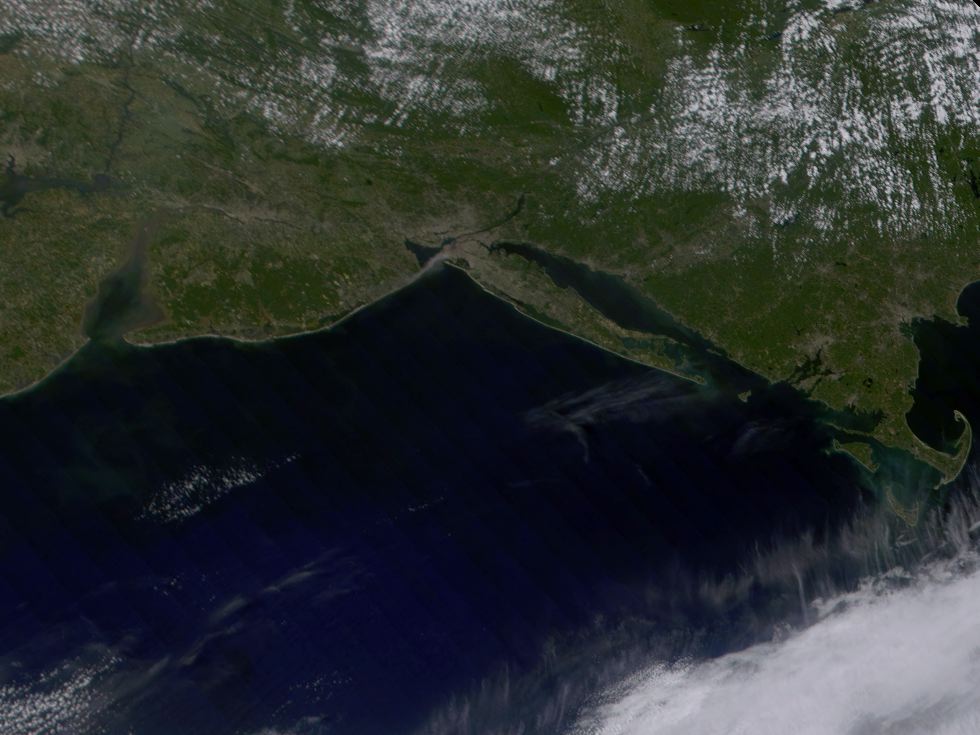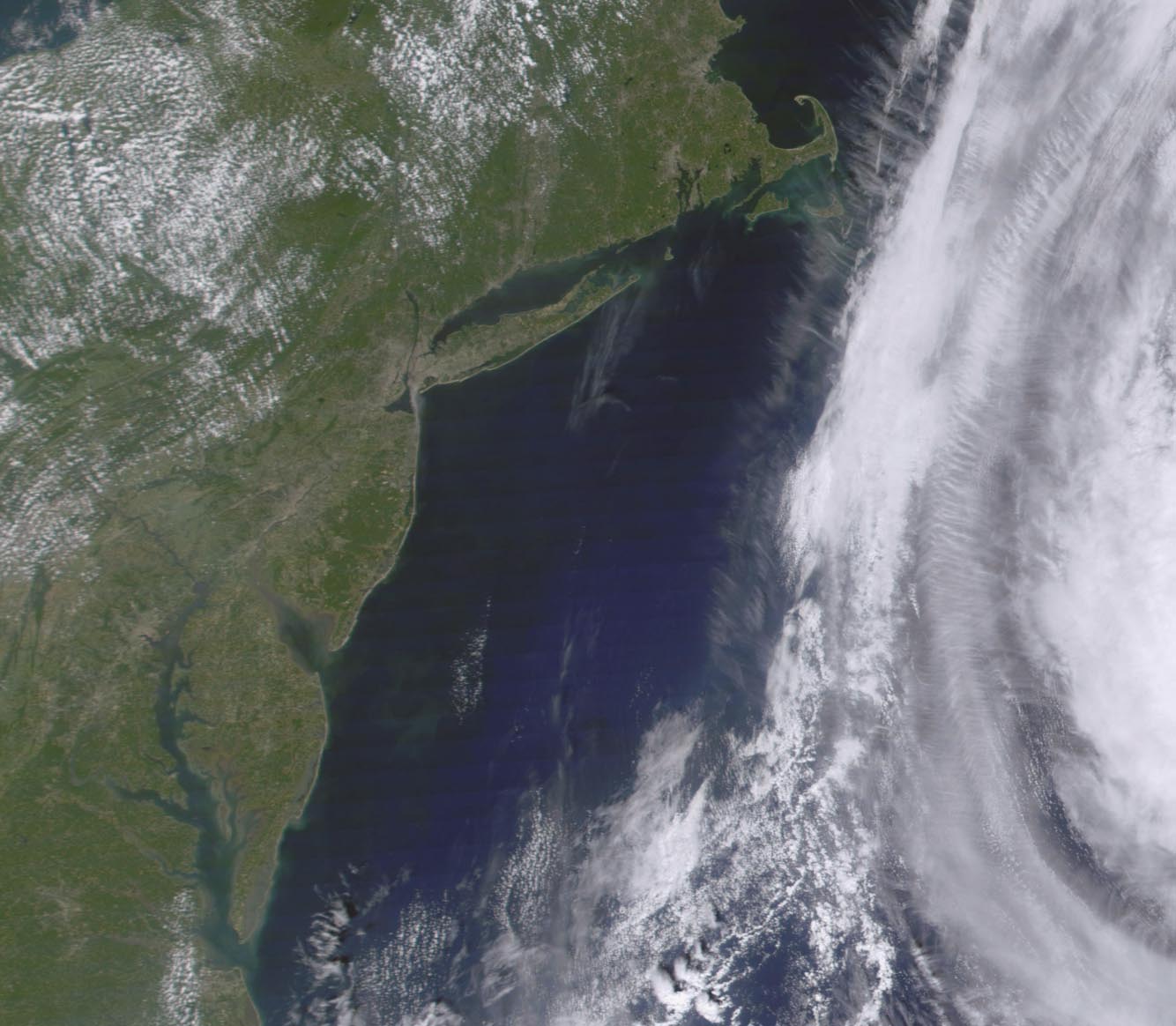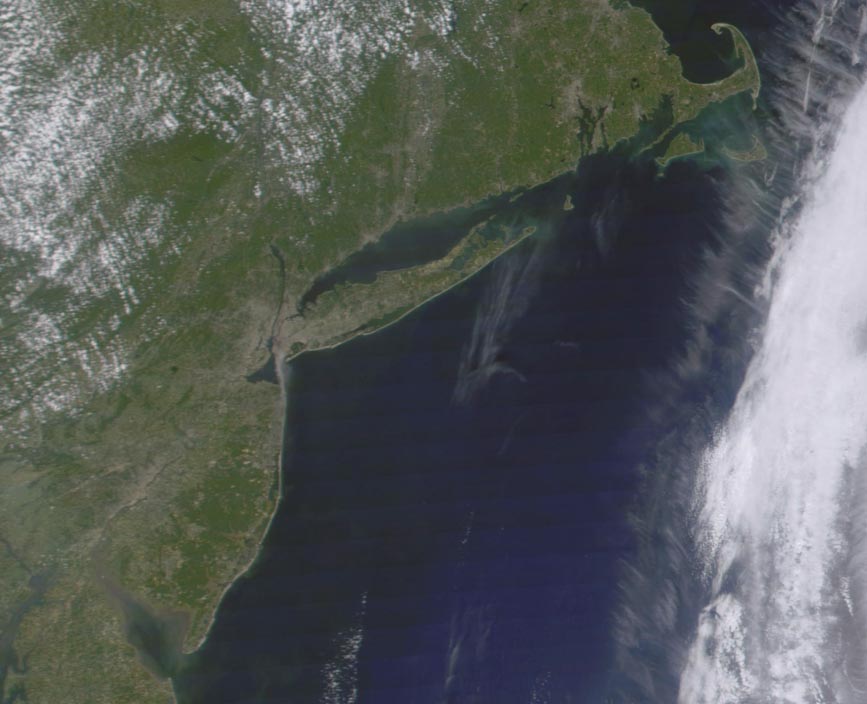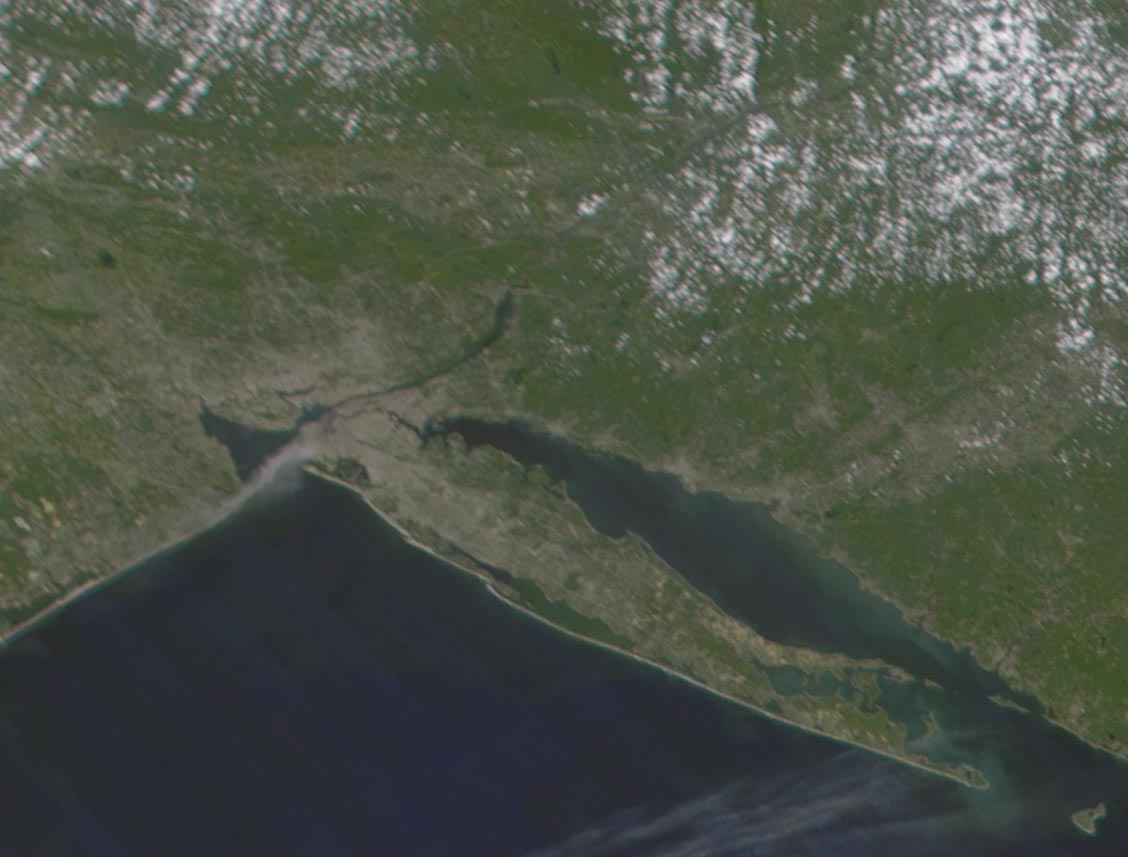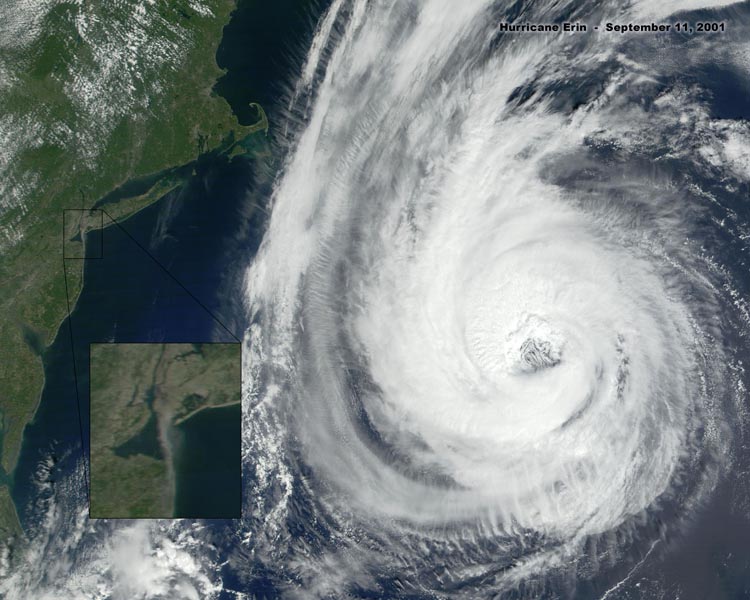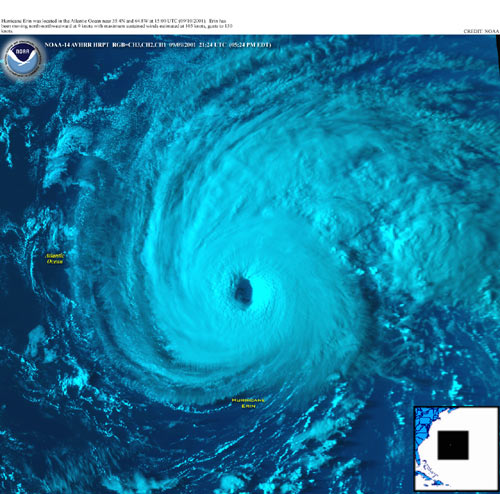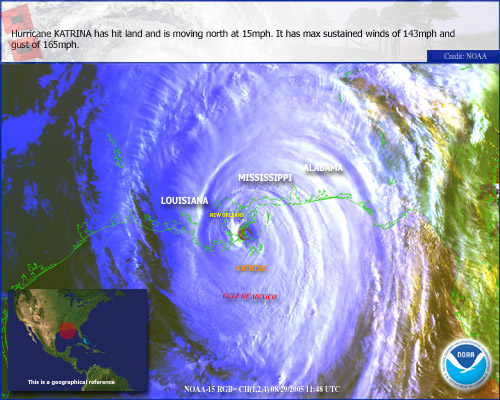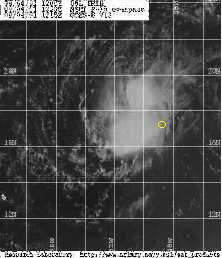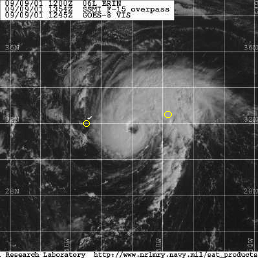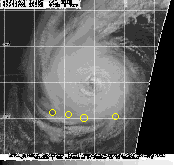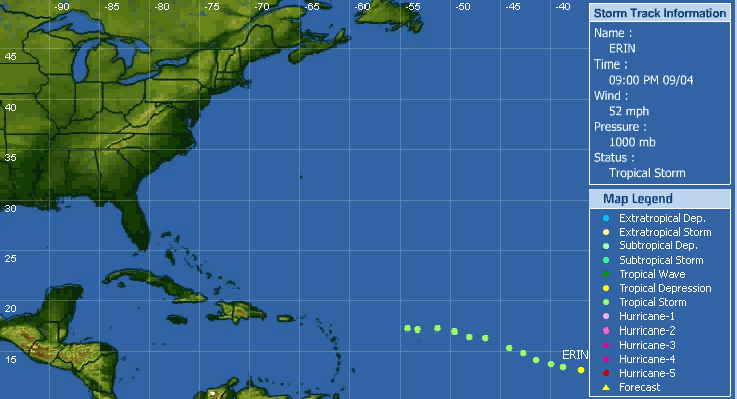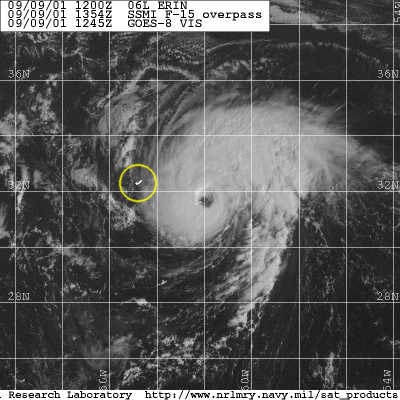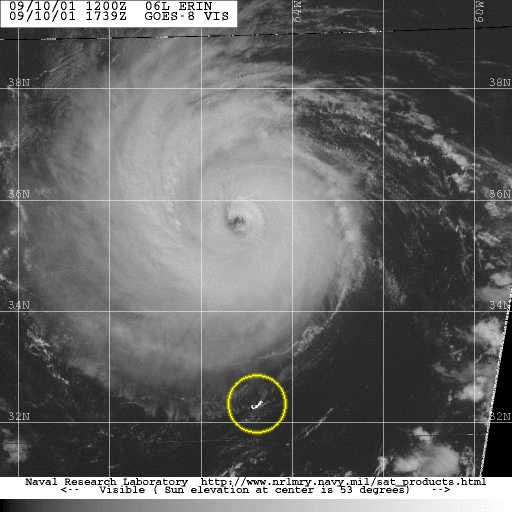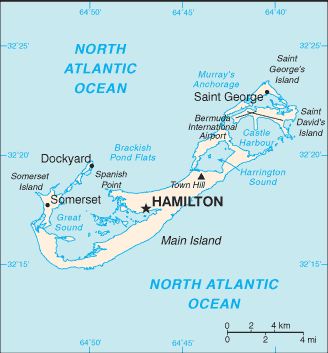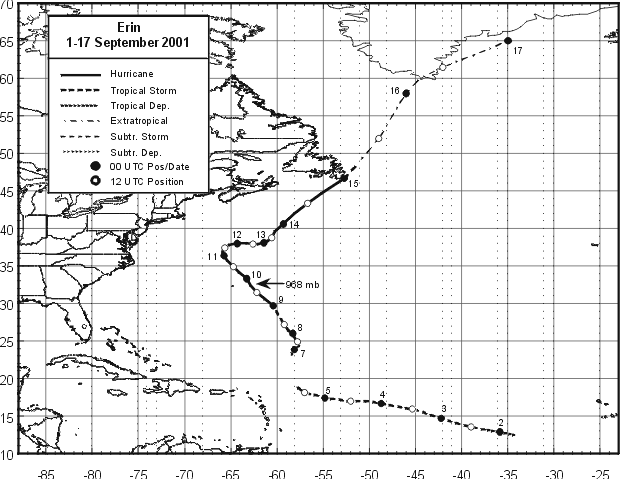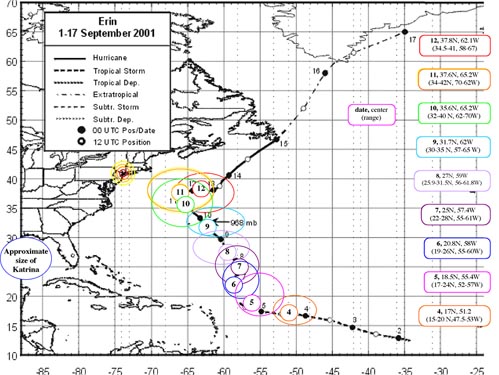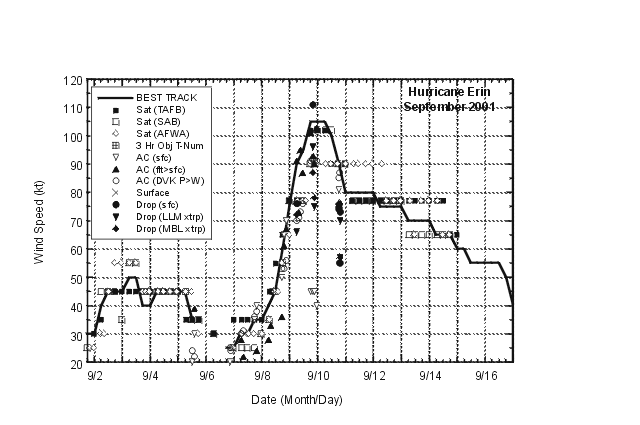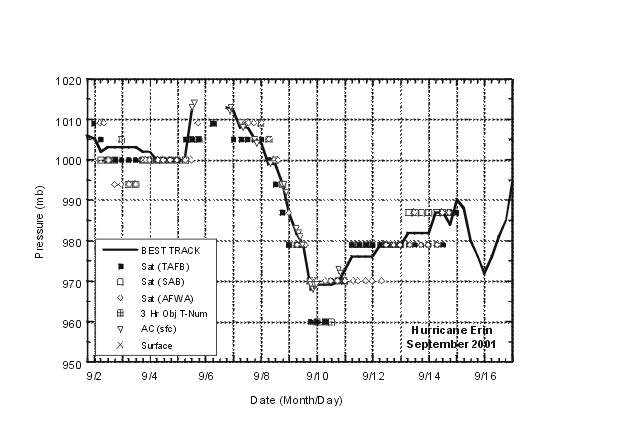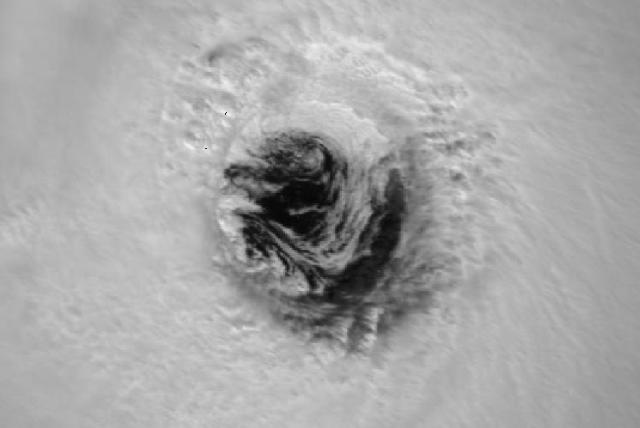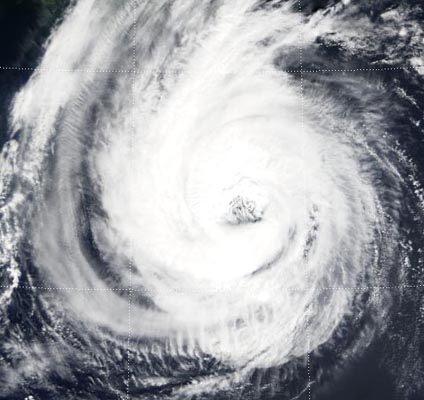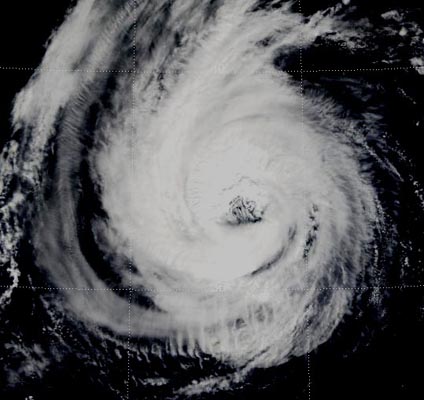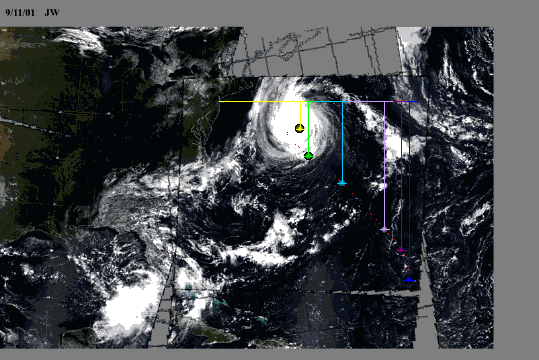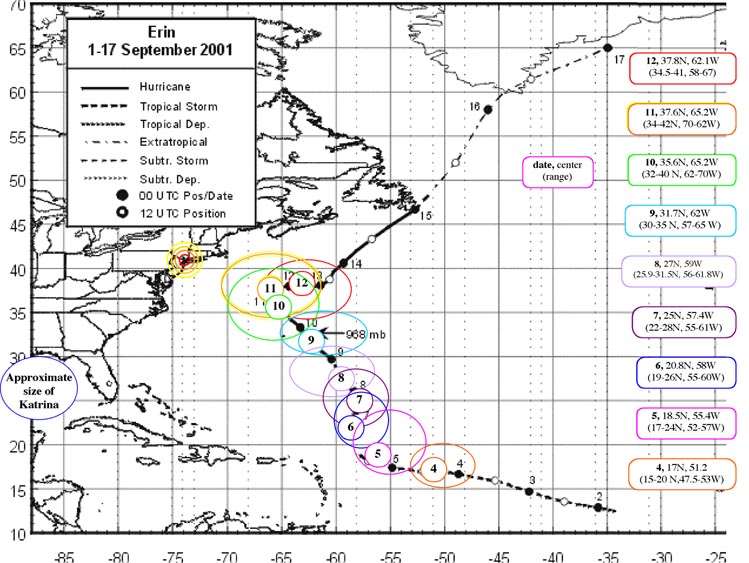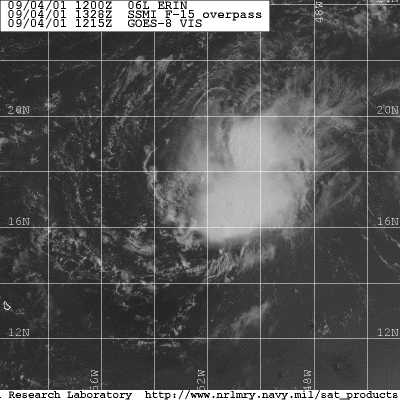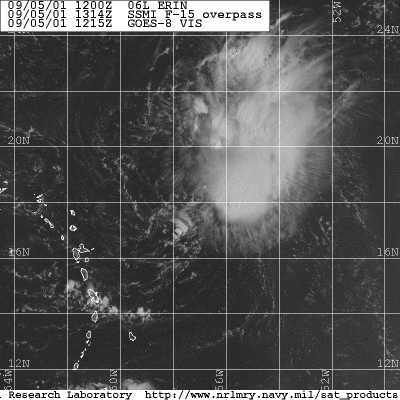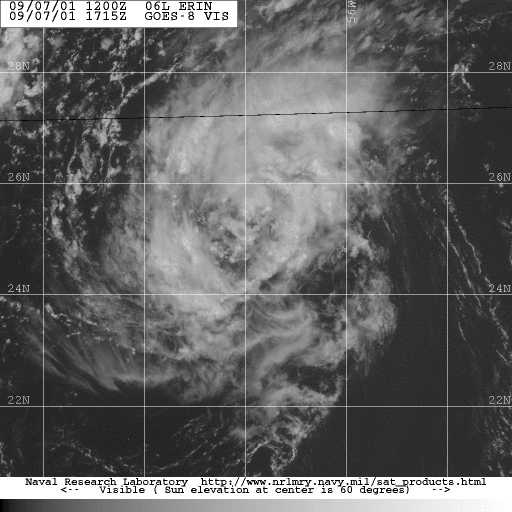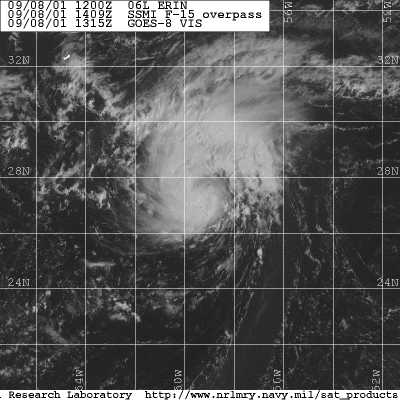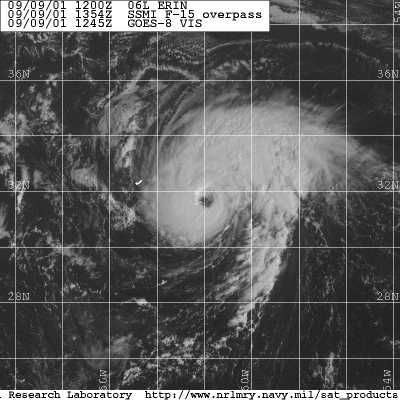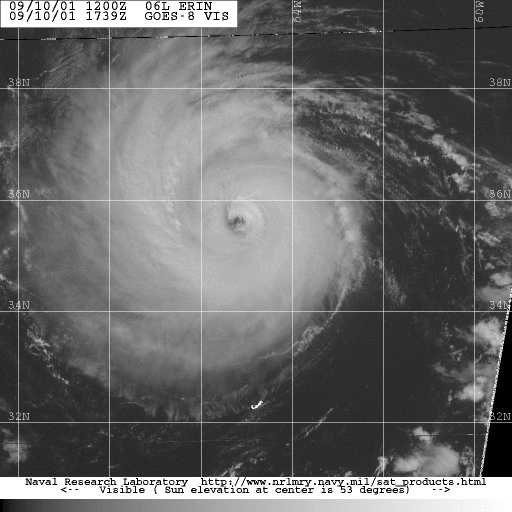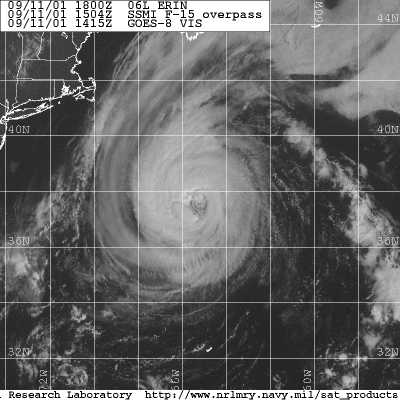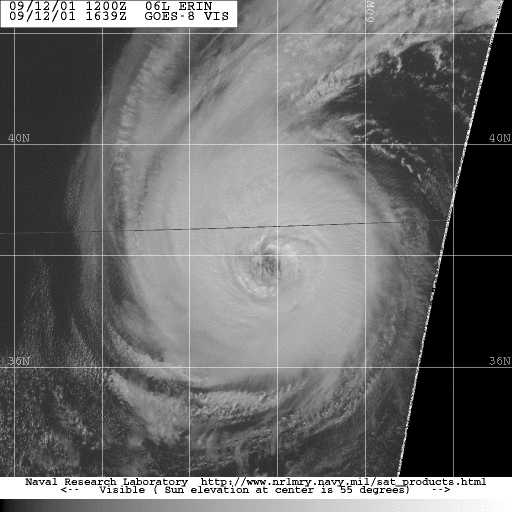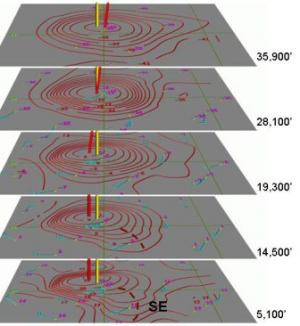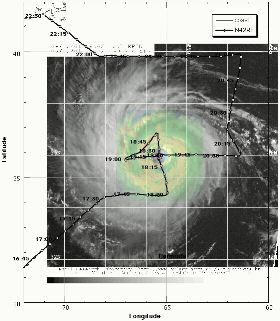Tropical Cyclone Report
Hurricane Erin
1 - 15 September 2001
Erin was the third of a series of four "interrupted track" tropical cyclones during the 2001 Atlantic hurricane season. After re-forming, it strengthened to a category three hurricane on the Saffir-Simpson Hurricane Scale, just to the east of Bermuda.
a. Synoptic History
Erin can be traced back to a tropical wave that emerged from western Africa on 30 August. The system almost immediately showed signs of tropical cyclone formation, with curvature in the bands of associated deep convection. Dvorak classifications commenced at 1800 UTC on the 30th. There was little change in the system's organization, and deep convection was sporadic for the next day or so. On 1 September the cloud pattern began to become better organized, and based on the satellite presentation as well as drifting buoy data that showed a definite closed surface circulation, it is estimated that a tropical depression formed by 1800 UTC that day, located about 600 n mi west-southwest of the Cape Verde Islands. With a mid-tropospheric ridge in place to its north, the tropical cyclone moved on a west to west-northwestward heading at 14-18 kt over the following three days.
At first, there was weak to moderate vertical shear over the area, and the cyclone was able to strengthen into Tropical Storm Erin by 0600 UTC 2 September. Erin's maximum winds increased to near 50 knots by 0600 UTC 3 September. Later on the 3rd, vertical shear associated with an upper-level low to the northwest caused the low-level center of the storm to become exposed to the southwest of the main area of deep convection, indicating that Erin had weakened. On the 4th, the shear appeared to lessen somewhat, and Erin re-strengthened slightly. However the system failed to become much better organized, and was soon on a weakening trend. By 5 September, southwesterly shear caused the tropical cyclone to degenerate into an area of disturbed weather.
About a day later, a surface circulation re-developed in the northern part of the area of disturbed weather that was associated with Erin. The re-generated tropical depression moved north-northeastward, then north-northwestward, and regained tropical storm strength about 550 n mi north-northeast of the northern Leeward Islands at 1800 UTC 7 September. After a mid-level ridge to the north of Erin was temporarily weakened by a passing trough, the ridge re-built, moving the storm toward the northwest and north-northwest. Erin strengthened into a hurricane late on the 8th. While passing east of Bermuda on the 9th, Erin continued to strengthen, and it reached its peak intensity of 105 kt around 1800 UTC that day. A few hours later, the eye of the hurricane passed within about 90 n mi east-northeast of Bermuda, which was Erin's point of closest approach to the island.
After brushing Bermuda, the hurricane continued to move mainly toward the north-northwest. On 10 September, Erin began to weaken, however the weakening was slower than usual over the ensuing days, due in part to slightly warmer than normal waters over the western subtropical Atlantic. A series of short-wave troughs weakened the western portion of the Atlantic subtropical ridge. This caused the motion of the hurricane to turn toward the right, with a decrease in forward speed, on the 11th. Erin's heading veered toward the east-northeast and east on the 12th. Then, a broad, amplifying mid- to upper-level trough over eastern Canada accelerated Erin toward the northeast. The center passed just east of Cape Race, Newfoundland at 0000 UTC, while the system was weakening to just below hurricane strength. Then, Erin lost its tropical characteristics. The extratropical storm accelerated north-northeastward and passed over southern Greenland on 16 September, and merged with high-latitude cyclonic flow over eastern Greenland on the 17th.
b. Meteorological Statistics
The "best track" map of Erin's path is given in Figure 1, and the best track positions and intensities are listed in Table 1. Time series of the wind and pressure histories of Erin are shown in Figure 2 and Figure 3, respectively. Observations in these figures include satellite-based Dvorak technique intensity estimates from the Tropical Analysis and Forecast Branch (TAFB), the Satellite Analysis Branch (SAB) and the U. S. Air Force Weather Agency (AFWA), as well as flight-level and dropwindsonde observations from flights of the 53rd Weather Reconnaissance Squadron of the U. S. Air Force Reserve Command.
Erin's peak intensity of 105 kt at 1800 UTC 9 September is a compromise of the following observations taken around that time: 90 percent of the maximum flight-level (700 mb) winds of 118 kt (106 kt); the surface reduction of the lowest 150 m of a dropwindsonde sounding, yielding 97 kt; and a surface value from that same sounding of 111 kt. Although the minimum central pressure value of 968 mb around the time of peak intensity would not typically support quite so high a wind speed, Erin was situated in an area of higher than average (for a tropical cyclone) environmental pressures. About 24 h after peak intensity, during 1900-2000 UTC 10 September, radar data and Stepped-Frequency Microwave Radiometer measurements from a NOAA aircraft showed that Erin had a concentric eyewall structure.
Bermuda reported a peak wind gust of 36 kt at 2300 UTC 9 September, about when the center of Erin was nearest to that island. Cape Race, Newfoundland reported sustained winds of 38 kt with a gust to 46 kt at 2100 UTC 14 September, and a sustained wind of 46 kt with a gust to 58 kt at 0200 UTC 15 September. St. John's, Newfoundland reported a gust to 45 kt at 0352 UTC. Grates Cove, Newfoundland reported a gust to 56 kt at 0449 UTC 15 September, and Bonavista Newfoundland reported sustained winds of 34 kt with a gust to 58 kt at 0536 UTC 15 September. Note that the observations after 0000 UTC 15 September occurred during the extratropical stage of Erin. Maximum rainfall totals from Newfoundland were 131 mm (5.1 in) at Sagona Island, 102 mm (4.0 in) at Burgeo, and 78 mm (3.1 in) at Bonavista.
Ship and buoy reports of winds of tropical storm force associated with Erin are listed in Table 2. There were a couple of drifting buoy observations of hurricane force winds near the tropical cyclone, at 0000 and 0300 UTC 4 September, which have been excluded because they were not consistent with nearby observations in time and/or space (the best track intensity was 40-45 kt around these times).
Figure 4 is a striking, high-resolution (250 m) visible image of the inner core of Erin just before its peak intensity, taken with the Moderate Resolution Imaging Spectroradiometer (MODIS) onboard the polar-orbiting NASA Terra satellite. Note the presence of two distinct vortices inside the eye. Such features have been observed before in intense hurricanes.
c. Casualty and Damage Statistics
There were no reports of damage or casualties associated with Erin.
d. Forecast and Warning Critique
Table 3 lists the average track forecast errors for Erin, for selected numerical guidance models and the official forecasts. It can be seen that the average official track forecasts for this tropical cyclone were better than the most recent ten-year averages at all forecast times. However, the AVNI and GFDI model forecasts had even lower average errors at almost all forecast times, especially at 72 h.
Average absolute official intensity errors were 5, 10, 15, 16, and 11 kt for the 12, 24, 36, 48, and 72 h forecasts, respectively. For comparison, the average official intensity errors over the 10-yr period of 1991-2000 are 7, 11, 14, 16, and 20 kt, respectively. So, the average NHC intensity forecasts for Erin were about the same as the long-term averages for 12 through 48 h, and somewhat better than average at 72 h. In general, Erin's strength was over-predicted during the first few days of its existence. In particular, the NHC forecasts never anticipated that the system was going to dissipate in the deep tropics. After Erin's re-formation, the NHC intensity forecasts were mostly under-predictions, and strengthening to a major hurricane was not forecast until just 12 h before it happened. For comparison, the average absolute errors of the SHIPS model intensity forecasts for Erin were 7, 11, 16, 20, and 24 kt.
Table 4 lists the watches and warnings associated with Erin. The government of Bermuda issued a hurricane watch 30 h before Erin's closest point of approach, and a hurricane warning 24 h before the closest point of approach to the island.
e. Acknowledgments
The high-resolution MODIS image of Erin was provided by Liam Gumley of the Space Science and Engineering Center of the University of Wisconsin-Madison. MODIS data acquired by direct broadcast from the NASA Terra spacecraft at the Space Science and Engineering Center, University of Wisconsin-Madison. Paul Vukits of the NOAA Marine Prediction Center provided analyses and high seas forecasts that were used to produce the extratropical portion of the best track.
|

